
The Local Group is the galaxy group that includes the Milky Way, where Earth is located. It has a total diameter of roughly 3 megaparsecs (10 million light-years; 9×1019 kilometres), and a total mass of the order of 2×1012 solar masses (4×1042 kg). It consists of two collections of galaxies in a "dumbbell" shape; the Milky Way and its satellites form one lobe, and the Andromeda Galaxy and its satellites constitute the other. The two collections are separated by about 800 kiloparsecs (3×10^6 ly; 2×1019 km) and are moving toward one another with a velocity of 123 km/s. The group itself is a part of the larger Virgo Supercluster, which may be a part of the Laniakea Supercluster. The exact number of galaxies in the Local Group is unknown as some are occluded by the Milky Way; however, at least 80 members are known, most of which are dwarf galaxies.
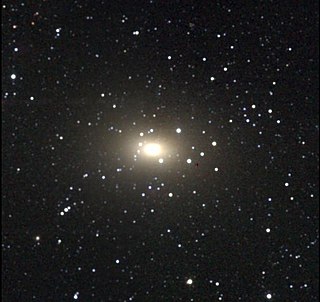
The IC 342/Maffei Group corresponds to one or two galaxy groups close to the Local Group. The member galaxies are mostly concentrated around either IC 342 or Maffei 1, which would be the brightest two galaxies in the group. The group is part of the Virgo Supercluster. However, recent studies have found that the two subgroups are unrelated; while the IC 342 group is the nearest galaxy group to the Milky Way, the Maffei 1 group is several times farther away, and is not gravitationally bound to the IC 342 group.
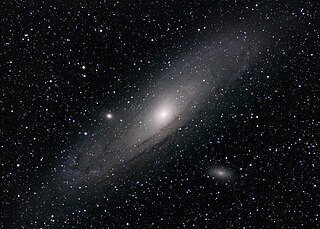
The Andromeda Galaxy is a barred spiral galaxy and is the nearest major galaxy to the Milky Way. It was originally named the Andromeda Nebula and is cataloged as Messier 31, M31, and NGC 224. Andromeda has a D25 isophotal diameter of about 46.56 kiloparsecs (152,000 light-years) and is approximately 765 kpc (2.5 million light-years) from Earth. The galaxy's name stems from the area of Earth's sky in which it appears, the constellation of Andromeda, which itself is named after the princess who was the wife of Perseus in Greek mythology.

The Great Attractor is a region of gravitational attraction in intergalactic space and the apparent central gravitational point of the Laniakea Supercluster of galaxies that includes the Milky Way galaxy, as well as about 100,000 other galaxies.

The Triangulum Galaxy is a spiral galaxy 2.73 million light-years (ly) from Earth in the constellation Triangulum. It is catalogued as Messier 33 or NGC (New General Catalogue) 598. With the D25 isophotal diameter of 18.74 kiloparsecs (61,100 light-years), the Triangulum Galaxy is the third-largest member of the Local Group of galaxies, behind the Andromeda Galaxy and the Milky Way.
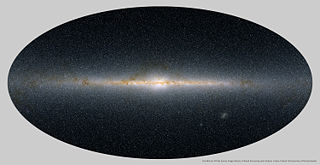
The Zone of Avoidance, or Zone of Galactic Obscuration (ZGO), is the area of the sky that is obscured by the Milky Way.
Dwingeloo 2 is a small irregular galaxy discovered in 1996 and located about 10 million light-years away from the Earth. Its discovery was a result of the Dwingeloo Obscured Galaxy Survey (DOGS) of the Zone of Avoidance using the Dwingeloo Radio Observatory. Dwingeloo 2 is a companion galaxy of Dwingeloo 1.

Messier 108 is a barred spiral galaxy about 28 million light-years away from Earth in the northern constellation Ursa Major. It was discovered by Pierre Méchain in 1781 or 1782. From the Earth, this galaxy is seen almost edge-on.
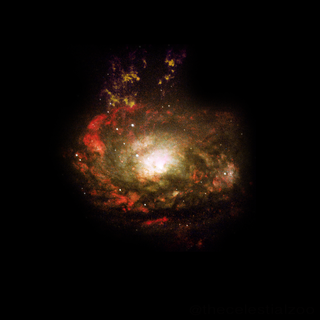
The Circinus Galaxy is a Seyfert galaxy in the constellation of Circinus. It is located 4 degrees below the Galactic plane, and, at a distance of 4.0 Mpc (13 Mly), is one of the closest major galaxies to the Milky Way. The galaxy is undergoing tumultuous changes, as rings of gas are likely being ejected from the galaxy. Its outermost ring is 1400 light-years across while the inner ring is 260 light-years across. Although the Circinus galaxy can be seen using a small telescope, it was not noticed until 1977 because it lies close to the plane of the Milky Way and is obscured by galactic dust. The Circinus Galaxy is a Type II Seyfert galaxy and is one of the closest known active galaxies to the Milky Way, though it is probably slightly farther away than Centaurus A.

NGC 1569 is a dwarf irregular galaxy in Camelopardalis. The galaxy is relatively nearby and consequently, the Hubble Space Telescope can easily resolve the stars within the galaxy. The distance to the galaxy was previously believed to be only 2.4 Mpc. However, in 2008 scientists studying images from Hubble calculated the galaxy's distance at nearly 11 million light-years away, about 4 million light-years farther than previously thought, meaning it is a member of the IC 342 group of galaxies.

The Milky Way is the galaxy that includes the Solar System, with the name describing the galaxy's appearance from Earth: a hazy band of light seen in the night sky formed from stars that cannot be individually distinguished by the naked eye.

IC 342 is an intermediate spiral galaxy in the constellation Camelopardalis, located relatively close to the Milky Way. Despite its size and actual brightness, its location behind dusty areas near the galactic equator makes it difficult to observe, leading to the nickname "The Hidden Galaxy", though it can readily be detected even with binoculars. If the galaxy were not obscured, it would be visible by naked eye. The dust makes it difficult to determine its precise distance; modern estimates range from about 7 million light-years (Mly) to about 11 Mly. The galaxy was discovered by William Frederick Denning in 1892. It is one of the brightest in the IC 342/Maffei Group, one of the closest galaxy groups to the Local Group. Edwin Hubble first thought it to be in the Local Group, but it was later determined not to be a member.

UGCA 86 is a Magellanic spiral galaxy. It was first thought to be part of the Local Group, but after the brightest stars in the galaxy were observed, it became clear that it was located in the IC 342/Maffei Group. UGCA 86 is thought to be a satellite galaxy of IC 342, however the separation between the two galaxies is over 50% larger than the distance between the Milky Way and the Magellanic Clouds.
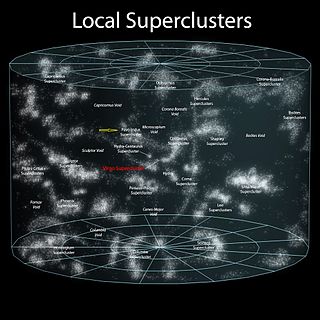
The Pavo–Indus Supercluster is a neighboring supercluster located about 60–70 Mpc (196–228 Mly) away in the constellations of Pavo, Indus, and Telescopium. The supercluster contains three main clusters, Abell 3656, Abell 3698, and Abell 3742.

Maffei 1 is a massive elliptical galaxy in the constellation Cassiopeia. Once believed to be a member of the Local Group of galaxies, it is now known to belong to a separate group, the IC 342/Maffei Group. It was named after Paolo Maffei, who discovered it and the neighboring Maffei 2 in 1967 via their infrared emissions.
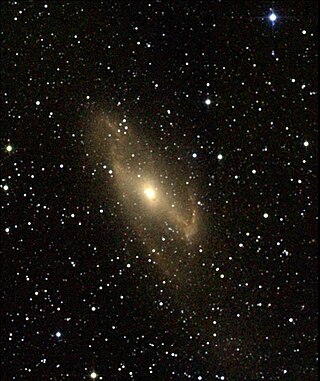
Maffei 2 is an intermediate spiral galaxy about 10 million light-years away in the constellation Cassiopeia. Maffei 2 and Maffei 1 were both discovered by Paolo Maffei in 1968 from their infrared emission. Maffei 2 lies in the Zone of Avoidance and is about 99.5% obscured by the Milky Way's foreground dust clouds, and as a result is barely detectable at optical wavelengths. It had been suggested soon after its discovery that Maffei 2 may be a member of the Local Group, but it is now thought to be a member of another nearby group, the IC 342/Maffei Group, the galaxy group that is the closest to the Local Group.
MB 3 is a dwarf spheroidal galaxy discovered in 1997 and located about 10 million light-years away from the Earth. It was discovered during an optical survey of the IC 342/Maffei group to which the galaxy is a member. MB3 is a companion galaxy of Dwingeloo 1 and situated in the Zone of Avoidance. MB 3 is thought to be a member of the IC 342/Maffei Group, a galaxy group adjacent to the Local Group.
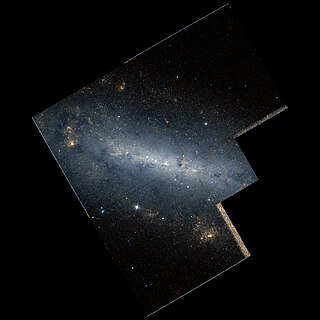
NGC 672 is a spiral galaxy in the northern constellation of Triangulum, positioned around 2° to the southwest of the star Alpha Trianguli. The original object designated NGC 672 was discovered by the German-born astronomer William Herschel on 26 October 1786, but this was later cataloged as NGC 614. The object now identified as NGC 672 was discovered by John Herschel on 11 November 1827.
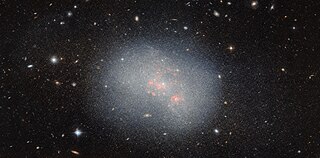
NGC 5238 is an irregular galaxy in the constellation Canes Venatici. Located at a comoving distance of 4.51 Mpc, it is 64.4 arcseconds in diameter. It has sometimes been classified as a blue compact dwarf galaxy. Although some authors have hypothesized it to be a member of the M101 Group of galaxies, it is currently believed to be an isolated galaxy.
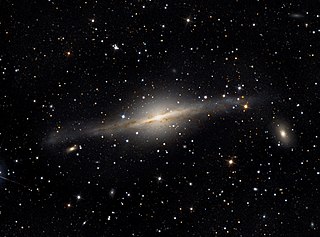
NGC 5084 is a lenticular galaxy in the constellation of Virgo. It is located at a distance of about 80 million light years from Earth, which, given its apparent dimensions, means that NGC 5084 is at least 200,000 light years across. It is one of the largest and most massive galaxies in the Virgo Supercluster. William Herschel discovered it on March 10, 1785. It is a member of the NGC 5084 Group of galaxies, which is a member of the Virgo II Groups, a series of galaxies and galaxy clusters strung out from the southern edge of the Virgo Supercluster. The galaxy is seen nearly edge-on, with inclination 86°, and features a warped disk and large quantities of HI gas extending along the disk, probably accumulated after multiple accretions of smaller galaxies.

















